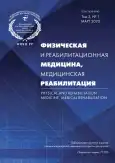Craniocerebral hypothermia as a therapeutic treatment option for thermal balance disturbances in post-comatose patients
- 作者: Shevelev O.A.1,2, Saidov S.K.1, Petrova M.V.1,2, Chubarova M.A.1, Usmanov E.S.1
-
隶属关系:
- Federal State Budgetary Scientific Institution “Federal Research and Clinical Center for Resuscitation and Rehabilitology”
- Peoples Friendship University of Russia
- 期: 卷 2, 编号 1 (2020)
- 页面: 11-19
- 栏目: ORIGINAL STUDY ARTICLE
- URL: https://bakhtiniada.ru/2658-6843/article/view/20411
- DOI: https://doi.org/10.36425/rehab20411
- ID: 20411
如何引用文章
全文:
详细
Background. Functional outcome in patients after cardiovascular, cerebral or traumatic injuries often remains unfavorable, what needs long rehabilitation and care.
Aims. Optimization of chronically critically ill patients treatment using selective craniocerebral hypothermia added to a standard intensive care.
Methods. Use of craniocerebral therapeutic hypothermia device «ATG-01» has greater clinical efficacy in mortality rate, CRS-R rate and modified Rankin scale rate, as well as decrease in disability rate. Treatment algorithm with the use of craniocerebral hypothermia device «ATG-01» has greater efficacy in cost- effectiveness analysis.
Results. Methods of multipositional SHF- radiothermometry and thermomonitoring, as well as non-invasive craniocerebral hypothermia used in chronically critically ill patients for the first time. Results of our research have showed high efficacy of these methods and let us optimistically estimate the perspective to involve CCH in rehabilitation interventions of such patients.
Conclusion. Our results can be used in Intensive Care Units of different medical institutions that provide healthcare to patients with brain damage and common central nervous system diseases that outcome to low level of consciousness.
作者简介
O. Shevelev
Federal State Budgetary Scientific Institution “Federal Research and Clinical Center for Resuscitation and Rehabilitology”; Peoples Friendship University of Russia
编辑信件的主要联系方式.
Email: shevelev_v@mail.ru
SPIN 代码: 9845-2960
д.м.н., профессор, главный научный сотрудник лаборатории клинической нейрофизиологии
俄罗斯联邦, 25-2, Petrovka street, Moscow,107031; 6, Miklukho-Maklaya street, Moscow, 117198Sh. Saidov
Federal State Budgetary Scientific Institution “Federal Research and Clinical Center for Resuscitation and Rehabilitology”
Email: shavkat_fmba@mail.ru
ORCID iD: 0000-0002-7619-7503
SPIN 代码: 6698-9408
к.м.н., старший научный сотрудник лаборатории клинической нейрофизиологии
俄罗斯联邦, 25-2, Petrovka street, Moscow,107031M. Petrova
Federal State Budgetary Scientific Institution “Federal Research and Clinical Center for Resuscitation and Rehabilitology”; Peoples Friendship University of Russia
Email: mpetrova@fnkcrr.ru
SPIN 代码: 9132-4190
д.м.н., заместитель директора по научно-клинической деятельности
俄罗斯联邦, 25-2, Petrovka street, Moscow,107031; 6, Miklukho-Maklaya street, Moscow, 117198M. Chubarova
Federal State Budgetary Scientific Institution “Federal Research and Clinical Center for Resuscitation and Rehabilitology”
Email: Mchubarova@fnkcrr.ru
SPIN 代码: 4406-7802
младший научный сотрудник лаборатории клинической нейрофизиологии
俄罗斯联邦, 25-2, Petrovka street, Moscow,107031E. Usmanov
Federal State Budgetary Scientific Institution “Federal Research and Clinical Center for Resuscitation and Rehabilitology”
Email: Eusmanov@fnkcrr.ru
SPIN 代码: 6273-2336
научный сотрудник лаборатории клинической нейрофизиологии
俄罗斯联邦, 25-2, Petrovka street, Moscow,107031参考
- Одинак М.М., Дыскин Д.Е. Клиническая диагностика в неврологии: руководство для врачей. — СПб.: СпецЛит, 2007. — 528 с. [Odinak MM, Dyskin DE. Klinicheskaya diagnostika v nevrologii: rukovodstvo dlya vrachey. Saint Petersburg: SpetsLit; 2007. 528 р. (In Russ.)]
- Гнездицкий В.В., Пирадов М.А. Нейрофизиология комы и нарушения сознания (анализ и интерпретация клинических наблюдений). — Иваново: ООО «Нейрософт»; ООО «ПресСто», 2015. — 524 с. [Gnezditskiy VV, Piradov MA. Neyrofiziologiya komy i narusheniya soznaniya (analiz i interpretatsiya klinicheskikh nablyudeniy). Ivanovo: OOO “Neyrosoft”; OOO “PresSto”; 2015. 524 с. (In Russ).]
- Han JW, van Leeuwen GM, Mizushina S, et al. Monitoring of deep brain temperature in infants using multi-frequency microwave radiometry and thermal modeling. Phys Med Biol. 2001;46(7):1885–1903. doi: 10.1088/0031-9155/46/7/311.
- Шевелев О.А., Бутров А.В., Чебоксаров Д.В., и др. Патогенетическая роль церебральной гипертермии при поражениях головного мозга // Клиническая медицина. — 2017. — Т. 95. — № 4. — С. 302−309. [Shevelev OA, Butrov AV, Cheboksarov DV, et al. The pathogenetic role of cerebral hyperthermia in brain lesion. Klinicheskaia meditsina. 2017;95(4):302−309. (In Russ).] doi: 10.18821/0023-2149-2017-95-4-302-309.
- Бутров А.В., Шевелев О.А., Чебоксаров Д.В. Церебральная гипертермия у больных ишемическим инсультом // Анестезиология и реаниматология. — 2015. — Т. 60. — № 45. — С. 19−20. [Butrov AV, Shevelev OA, Cheboksarov DV. Tserebral’naya gipertermiya u bol’nykh ishemicheskim insul’tom. Anesteziol Reanimatol. 2015; 60(45):19−20. (In Russ).]
- Чебоксаров Д.В., Бутров А.В., Шевелев О.В., и др. Диагностические возможности неинвазивного термомониторинга головного мозга // Анестезиология и реаниматология. — 2015. — Т. 60. — № 1. — С. 66−69. [Cheboksarov DV, Butrov AV, Shevelev OA, et al. Diagnostic opportunities of noninvasive brain thermomonitoring. Anesteziol Reanimatol. 2015;60(1):66−69. (In Russ).]
- Durukan A, Tatlisumak T. Preconditioning-induced ischemic tolerance: a window into endogenous gearing for cerebroprotection. Exp Transl Stroke Med. 2010;2(1):2–10. doi: 10.1186/2040-7378-2-2.
- NM, Connick P, Livesey MR, et al. Hypothermic preconditioning reverses tau ontogenesis in human cortical neurons and is mimicked by protein phosphatase 2a inhibition. 2015;3:141−154. doi: 10.1016/j.ebiom.2015.12.010.
- Calderwood SK, Gong J, Theriault JR. Cell stress proteins: novel immunotherapeutics. Novartis Found Symp. 2008; 291:115–131. doi: 10.1002/9780470754030.ch9.
- Kaneko T, Kibayashi K. Mild hypothermia facilitates the expression of cold-inducible RNA-binding protein and heat shock protein 70.1 in mouse brain. Brain Res. 2012;1466:128−136. doi: 10.1016/j.brainres. 2012.05.001.
- Торосян Б.Д., Бутров А.В., Шевелев О.А., и др. Влияние краниоцеребральной гипотермии на метаболизм у пациентов в остром периоде ишемического инсульта // Медицинский алфавит. — 2018. — Т. 1. — № 9. — С. 41−44. [Torosyan BJ, Butrov AV, Shevelev OA, et al. Influence of cranio-cerebral hypothermia on metabolism in patients in acute period of ischemic stroke. Meditsinskiy alfavit. 2018;1(9):41−44. (In Russ).]
- Шевелев О.А., Петрова М.В., Саидов Ш.Х., и др. Терапевтическая гипотермия как метод альтернативного прекондиционирования // Вестник неврологии, психиатрии и нейрохирургии. — 2018. — № 11. — С. 50−59. [Shevelev OA, Petrova MV, Saidov ShH, et al. Hypothermic preconditioning. Vestnik nevrologii, psikhiatrii i neyrokhirurgii. 2018;(11):50−59. (In Russ).]
- Торосян Б.Д., Бутров А.В., Шевелев О.А., и др. Краниоцеребральная гипотермия — эффективное средство нейропротекции у пациентов с инфарктом мозга // Анестезиология и реаниматология. — 2018. — Т. 3. — С. 58−63. [Torosyan BJ, Butrov AV, Shevelev OA, et al. Craniocerebral hypothermia is an effective component of neuroprotection in patients with ischemic stroke. Anesteziol Reanimatol. 2018;(3):58−63. (In Russ).] doi: 10.17116/anaesthesiology201803158.
- Eldadah BA, Faden AI. Caspase pathways, neuronal apoptosis, and CNS injury. J Neurotrauma. 2000;17(10): 811−829. doi: 10.1089/neu.2000.17.811.
补充文件







